Enhancing the Photocurrent of Top-Cell by Ellipsoidal Silver Nanoparticles: Towards Current-Matched GaInP/GaInAs/Ge Triple-Junction Solar Cells
Abstract
:1. Introduction
2. Experiments
3. Results and Discussion
3.1. Epitaxial Structure and Performance of GaInP/GaInAs/Ge TJSCs
3.2. Morphology and Optical Properties of Ag NPs
3.3. Enhanced Performance of GaInP/GaInAs/Ge TJSCs by Ag NPs
4. Conclusions
Acknowledgments
Author Contributions
Conflicts of Interest
References
- Green, M.A.; Emery, K.; Hishikawa, Y.; Warta, W.; Dunlop, E.D. Solar cell efficiency tables (version 46). Prog. Photovolt. Res. Appl. 2015, 23, 805–812. [Google Scholar] [CrossRef]
- Green, M.A.; Keevers, M.J.; Thomas, I.; Lasich, J.B.; Emery, K.; King, R.R. 40% efficient sunlight to electricity conversion. Prog. Photovolt. Res. Appl. 2015, 23, 685–691. [Google Scholar] [CrossRef]
- Li, S.I.; Bi, J.F.; Li, M.Y.; Yang, M.J.; Song, M.H.; Liu, G.Z.; Xiong, W.P.; Li, Y.; Fang, Y.Y.; Chen, C.Q.; et al. Investigation of GaInAs strain reducing layer combined with InAs quantum dots embedded in Ga(In)As subcell of triple junction GaInP/Ga(In)As/Ge solar cell. Nanoscale Res. Lett. 2015, 10. [Google Scholar] [CrossRef] [PubMed]
- Paraskeva, V.; Hadjipanayi, M.; Norton, M.; Pravettoni, M.; Georghiou, G.E. Voltage and light bias dependent quantum efficiency measurements of GaInP/GaInAs/Ge triple junction devices. Sol. Energy Mater. Sol. Cells 2013, 116, 55–60. [Google Scholar] [CrossRef]
- Barrigon, E.; Espinet-Gonzalez, P.; Contreras, Y.; Rey-Stolle, I. Implications of low breakdown voltage of component subcells on external quantum efficiency measurements of multijunction solar cells. Prog. Photovolt. Res. Appl. 2015, 23, 1597–1607. [Google Scholar] [CrossRef]
- Geisz, J.F.; Kurtz, S.; Wanlass, M.W.; Ward, J.S.; Duda, A.; Friedman, D.J.; Olson, J.M.; McMahon, W.E.; Moriarty, T.E.; Kiehl, J.T. High-efficiency GaInP/GaAs/InGaAs triple-junction solar cells grown inverted with a metamorphic bottom junction. Appl. Phys. Lett. 2007, 91. [Google Scholar] [CrossRef]
- Dimroth, F.; Grave, M.; Beutel, P.; Fiedeler, U.; Karcher, C.; Tibbits, T.N.D.; Oliva, E.; Siefer, G.; Schachtner, M.; Wekkeli, A.; et al. Wafer bonded four-junction GaInP/GaAs//GaInAsP/GaInAs concentrator solar cells with 44.7% efficiency. Prog. Photovolt. Res. Appl. 2014, 22, 277–282. [Google Scholar] [CrossRef]
- Guter, W.; Schone, J.; Philipps, S.P.; Steiner, M.; Siefer, G.; Wekkeli, A.; Welser, E.; Oliva, E.; Bett, A.W.; Dimroth, F. Current-matched triple-junction solar cell reaching 41.1% conversion efficiency under concentrated sunlight. Appl. Phys. Lett. 2009, 94. [Google Scholar] [CrossRef]
- Kurtz, S.; Geisz, J. Multijunction solar cells for conversion of concentrated sunlight to electricity. Opt. Express 2010, 18, A73–A78. [Google Scholar] [CrossRef] [PubMed]
- Pham, N.D.; Kim, J.T.; Jung, T.I.; Han, J.H.; Oh, I. Direct solar water splitting enabled by monolithic III–V triple junction integrated with low-cost catalyst. Sci. Adv. Mater. 2016, 8, 241–246. [Google Scholar] [CrossRef]
- Braun, A.; Katz, E.A.; Gordon, J.M. Basic aspects of the temperature coefficients of concentrator solar cell performance parameters. Prog. Photovolt. Res. Appl. 2013, 21, 1087–1094. [Google Scholar] [CrossRef]
- Meusel, M.; Baur, C.; Létay, G.; Bett, A.W.; Warta, W.; Fernandez, E. Spectral response measurements of monolithic GaInP/Ga(In)As/Ge triple-junction solar cells: Measurement artifacts and their explanation. Prog. Photovolt. Res. Appl. 2003, 11, 499–514. [Google Scholar] [CrossRef]
- Sogabe, T.; Ogura, A.; Okada, Y. Analysis of bias voltage dependent spectral response in Ga0.51In0.49P/Ga0.99In0.01As/Ge triple junction solar cell. J. Appl. Phys. 2014, 115. [Google Scholar] [CrossRef]
- Cotal, H.; Fetzer, C.; Boisvert, J.; Kinsey, G.; King, R.; Hebert, P.; Yoon, H.; Karam, N. III-V multijunction solar cells for concentrating photovoltaics. Energy Environ. Sci. 2009, 2, 174–192. [Google Scholar] [CrossRef]
- Conibeer, G. Third-generation photovoltaics. Mater. Today 2007, 10, 42–50. [Google Scholar] [CrossRef]
- Lee, S.M.; Kwong, A.; Jung, D. High performance ultrathin GaAs solar cells enabled with heterogeneously integrated dielectric periodic nanostructures. ACS Nano 2015, 9, 10356–10365. [Google Scholar] [CrossRef] [PubMed]
- Okamoto, H.; Imura, K. Near-field optical imaging of enhanced electric fields and plasmon waves in metal nanostructures. Prog. Surf. Sci. 2009, 84, 199–229. [Google Scholar] [CrossRef]
- Bai, Y.M.; Gao, Z.; Chen, N.F.; Liu, H.; Yao, J.X.; Ma, S.; Shi, X.Q. Elimination of small-sized Ag nanoparticles via rapid thermal annealing for high efficiency light trapping structure. Appl. Surf. Sci. 2014, 315. [Google Scholar] [CrossRef]
- Yang, L.; Pillai, S.; Green, M.A. Can plasmonic Al nanoparticles improve absorption in triple junction solar cells? Sci. Rep. 2015, 5. [Google Scholar] [CrossRef] [PubMed]
- Zhang, Z.C.; Han, S.; Wang, C.; Li, J.P.; Xu, G.B. Single-walled carbon nanohorns for energy applications. Nanomaterials 2015, 5, 1732–1755. [Google Scholar] [CrossRef]
- Bai, Y.M.; Wang, J.; Yin, Z.G.; Chen, N.F.; Zhang, X.W.; Zhen, F.; Yao, J.X.; Li, N.; Guli, M.N. Ag nanoparticles preparation and their light trapping performance. Sci. China Technol. Sci. 2013, 56, 109–114. [Google Scholar] [CrossRef]
- Stratakis, E.; Kymakis, E. Nanoparticle-based plasmonic organic photovoltaic devices. Mater. Today 2013, 16, 133–146. [Google Scholar] [CrossRef]
- Lee, D.S.; Kim, W.; Cha, B.G.; Kwon, J.; Kim, S.J.; Kim, M.; Kim, J.; Wang, D.H.; Park, J.H. Self-position of Au NPs in perovskite solar cells: Optical and electrical contribution. ACS Appl. Mater. Interfaces 2015, 8, 449–454. [Google Scholar] [CrossRef] [PubMed]
- Keding, R.; Stuwe, D.; Kamp, M.; Kamp, M.; Reichel, C.; Wolf, A.; Woehl, R.; Borchert, D.; Reinecke, H.; Biro, D. Co-diffused back-contact back-junction silicon solar cells without gap regions. IEEE J. Photovolt. 2013, 3, 1236–1242. [Google Scholar] [CrossRef]
- Simrick, N.J.; Kilner, J.A.; Atkinson, A. Thermal stability of silver thin films on zirconia substrates. Thin Solid Films 2012, 520, 2855–2867. [Google Scholar] [CrossRef]
- Hu, P.F.; Cao, Y.L.; Jia, D.Z.; Li, Q.; Liu, R.L. Engineering the metathesis and oxidation-reduction reaction in solid state at room temperature for nanosynthesis. Sci. Rep. 2014, 4. [Google Scholar] [CrossRef] [PubMed]
- Fetzer, C.M.; King, R.R.; Colter, P.C.; Edmondson, K.M.; Law, D.C.; Stavrides, A.P.; Yoon, H.; Ermer, J.H.; Romero, M.J.; Karam, N.H. High-efficiency metamorphic GaInP/GaInAs/Ge solar cells grown by MOVPE. J. Cryst. Growth 2004, 261, 341–348. [Google Scholar] [CrossRef]
- King, R.R.; Law, D.C.; Edmondson, K.M.; Fetzer, C.M.; Kinsey, G.S.; Yoon, H.; Sherif, R.A.; Karam, N.H. 40% efficient metamorphic GaInP/GaInAs/Ge multijunction solar cells. Appl. Phys. Lett. 2007, 90. [Google Scholar] [CrossRef]
- Hoheisel, R.; Fernandez, J.; Dimroth, F.; Bett, A.W. Investigation of radiation hardness of germanium photovoltaic cells. IEEE Trans. Electron Devices 2010, 57, 2190–2194. [Google Scholar] [CrossRef]
- Draine, B.T.; Flatau, P.J. User guide for the discrete dipole approximation code DDSCAT (Version 7.1). 2010. Available online: http://arxiv.org/abs/1002.1505 (accessed on 28 January 2016).
- Palik, E.D. Handbook of Optical Constants of Solids; Academic Press: Washington, DC, USA, 1985. [Google Scholar]
- Gao, H.L.; Zhang, X.W.; Yin, Z.G.; Tan, H.R.; Zhang, S.G.; Meng, J.H.; Liu, X. Plasmon enhanced polymer solar cells by spin-coating Au nanoparticles on indium-tin-oxide substrate. Appl. Phys. Lett. 2012, 101. [Google Scholar] [CrossRef]
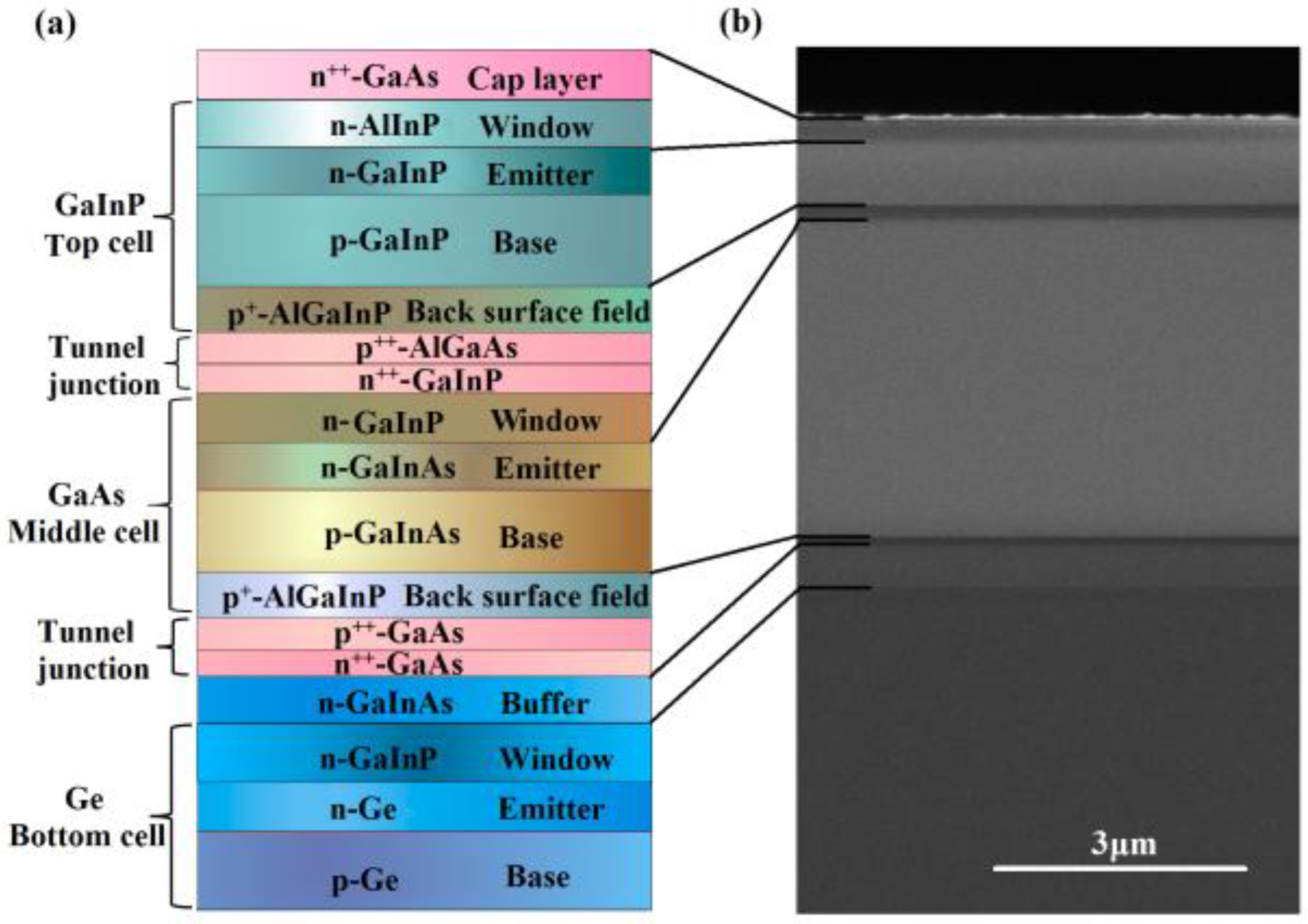
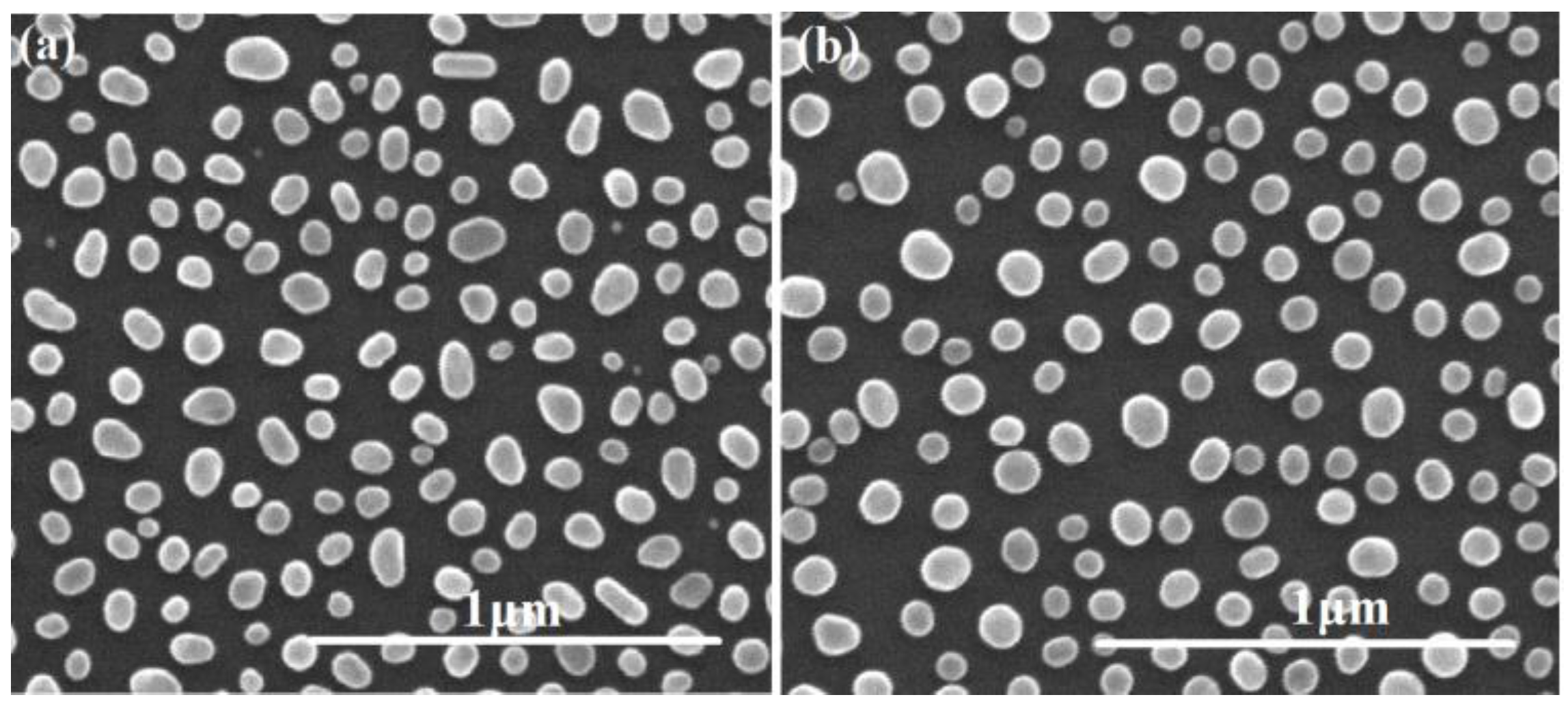
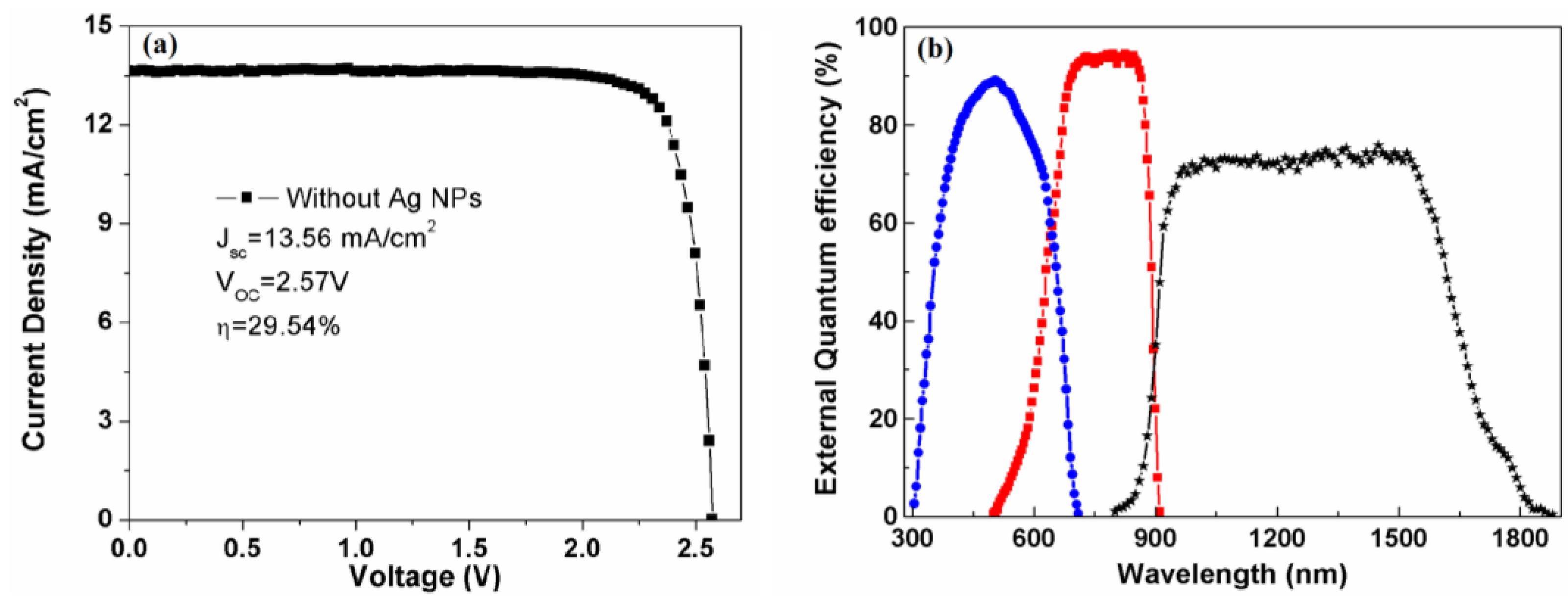
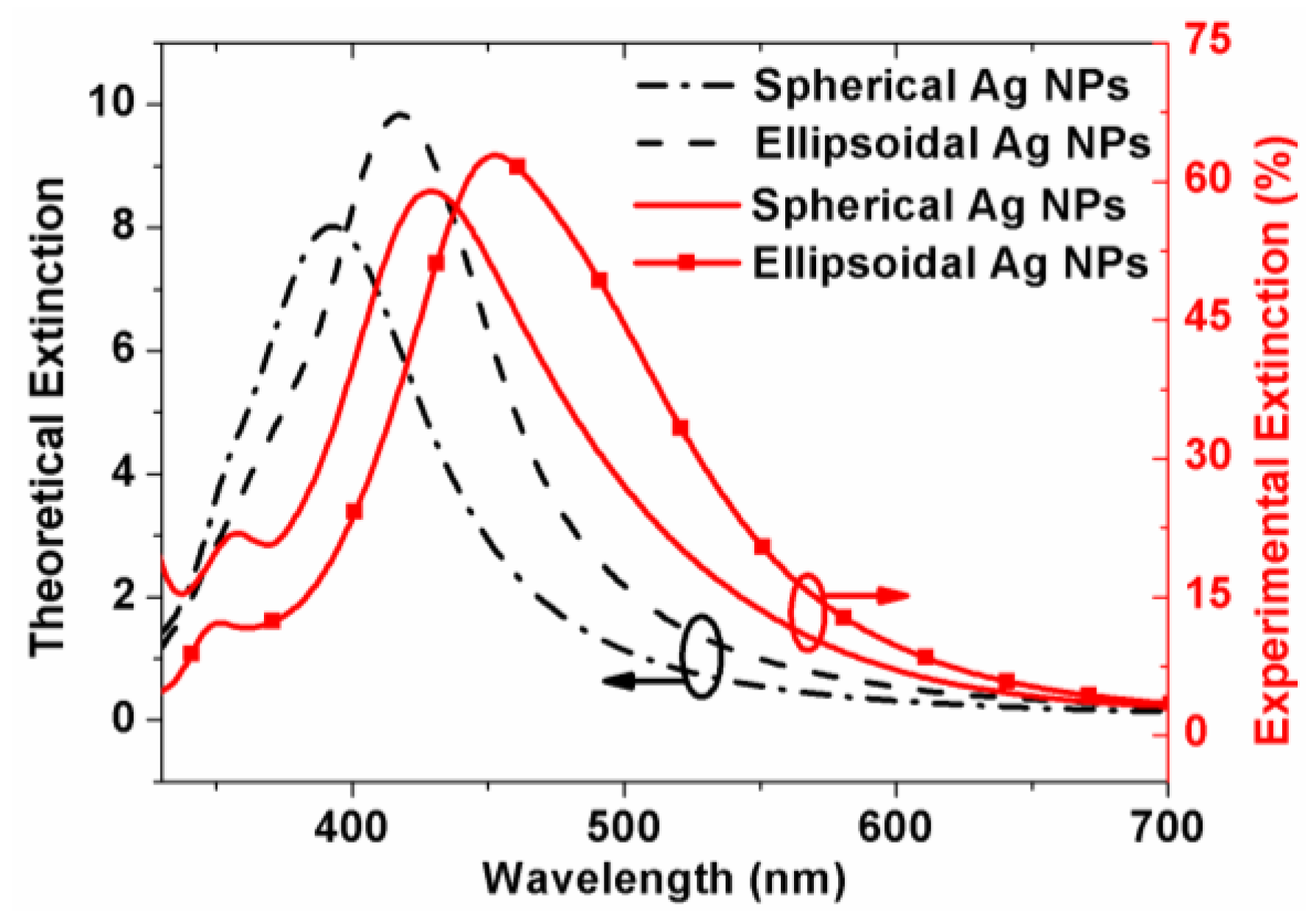
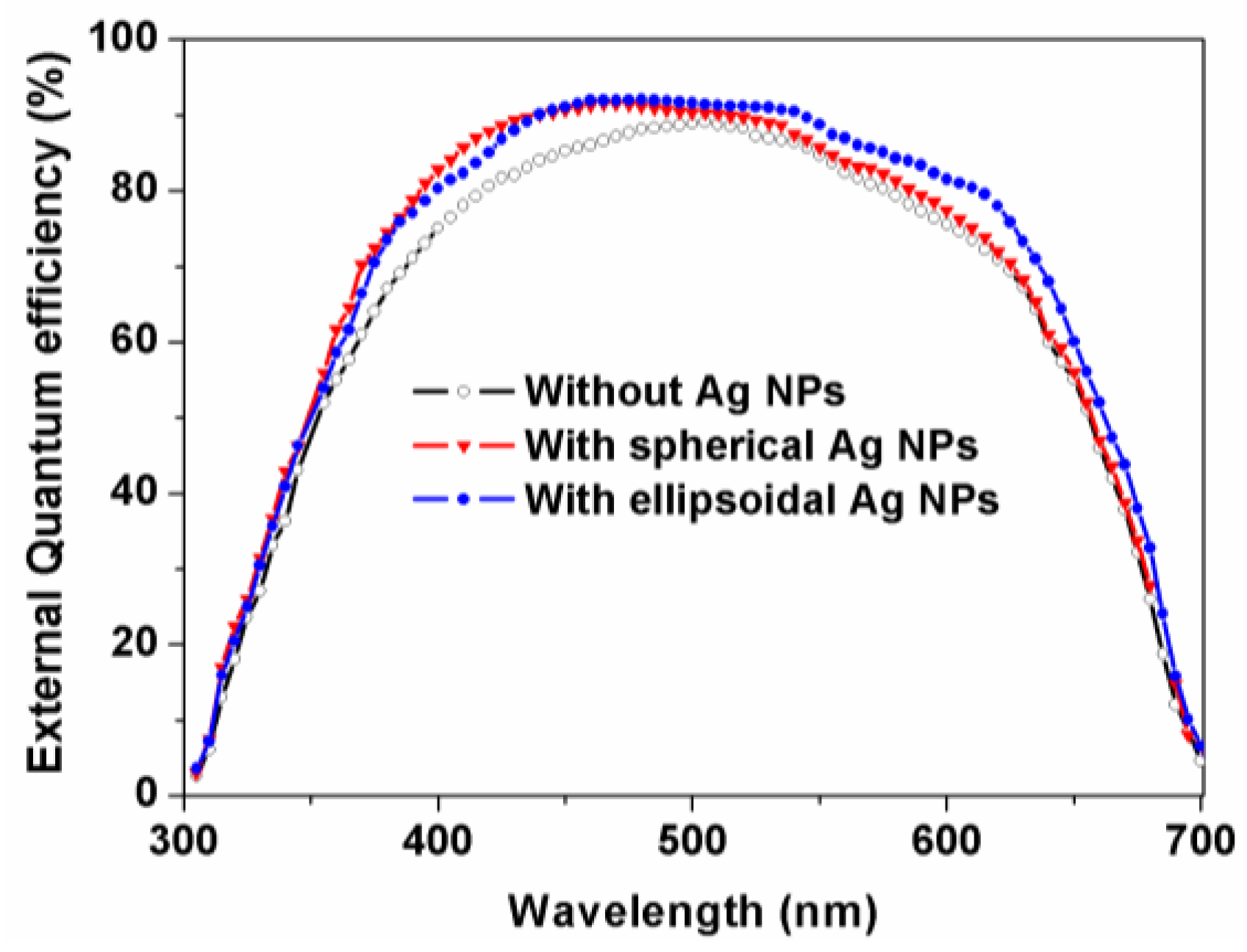
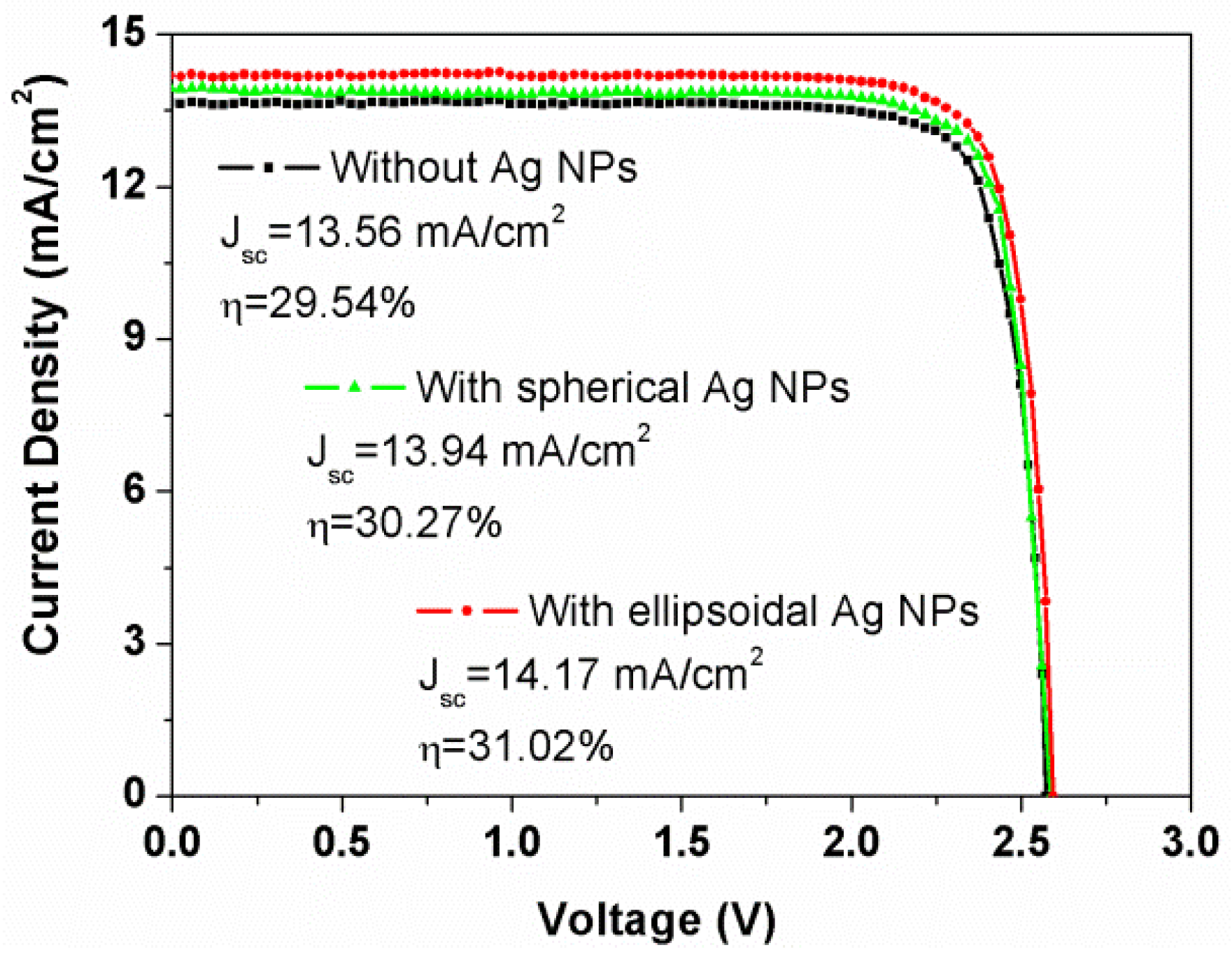
© 2016 by the authors; licensee MDPI, Basel, Switzerland. This article is an open access article distributed under the terms and conditions of the Creative Commons Attribution (CC-BY) license (http://creativecommons.org/licenses/by/4.0/).
Share and Cite
Bai, Y.; Yan, L.; Wang, J.; Su, L.; Yin, Z.; Chen, N.; Liu, Y. Enhancing the Photocurrent of Top-Cell by Ellipsoidal Silver Nanoparticles: Towards Current-Matched GaInP/GaInAs/Ge Triple-Junction Solar Cells. Nanomaterials 2016, 6, 98. https://doi.org/10.3390/nano6060098
Bai Y, Yan L, Wang J, Su L, Yin Z, Chen N, Liu Y. Enhancing the Photocurrent of Top-Cell by Ellipsoidal Silver Nanoparticles: Towards Current-Matched GaInP/GaInAs/Ge Triple-Junction Solar Cells. Nanomaterials. 2016; 6(6):98. https://doi.org/10.3390/nano6060098
Chicago/Turabian StyleBai, Yiming, Lingling Yan, Jun Wang, Lin Su, Zhigang Yin, Nuofu Chen, and Yuanyuan Liu. 2016. "Enhancing the Photocurrent of Top-Cell by Ellipsoidal Silver Nanoparticles: Towards Current-Matched GaInP/GaInAs/Ge Triple-Junction Solar Cells" Nanomaterials 6, no. 6: 98. https://doi.org/10.3390/nano6060098





